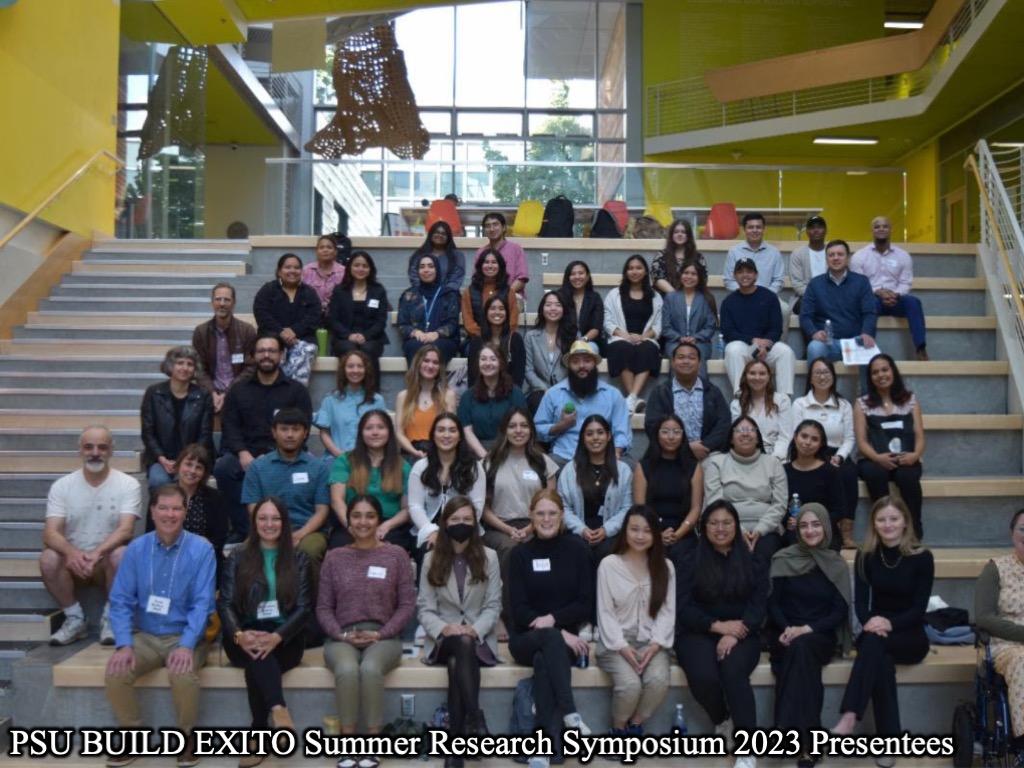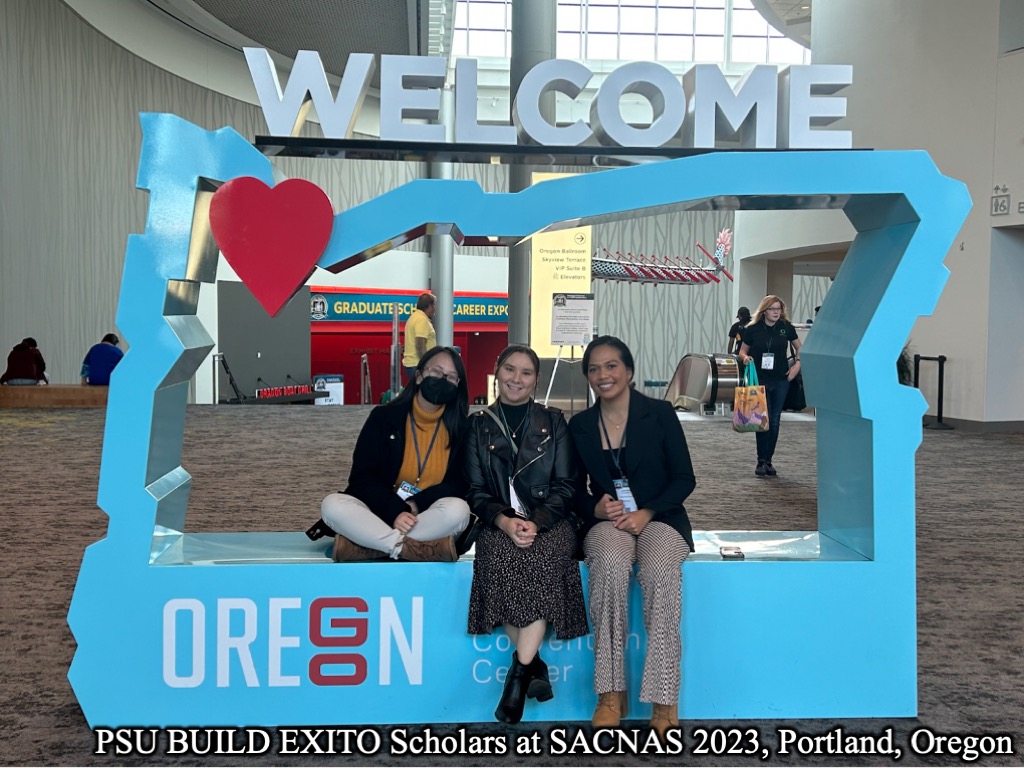Post by Connie Tran, undergraduate in Biology pursuing an Interdisciplinary Neuroscience minor at Portland State University. Connie is a research assistant in Dr. Martin Schreiber‘s lab in the Donald D. Trunkey Center for Civilian and Combat Casualty Care at OHSU.

Connie Tran at her research poster during the PSU BUILD EXITO Summer Research Symposium 2023
Entering college as a first-generation student and a second-generation immigrant was for me unknown and unexpected territory, especially during the COVID pandemic in 2020.
I had enrolled in the Bachelors of Science Biology program in the Pre-Medicine pathway at PSU, but I had so much uncertainty about what I’d chosen. It wasn’t until I learned about the BUILD EXITO program, an undergraduate research program for those underrepresented (or not currently overrepresented) in STEM, that I knew the path that I wanted to take involves both medicine and research.

Photo from the BUILD EXITO program website.
I had learned about BUILD EXITO and how to apply during my first year at Portland State. Once accepted, I was matched with a Research Learning Committee (or RLC); a.k.a. a research lab that best fit my interests. I was given the opportunity to intern as a research assistant at the Donald D. Trunkey Center for Civilian and Combat Casualty Care led by Dr. Martin Schreiber, who is a Professor and Head of the Division of Trauma, Critical Care and Acute Care Surgery at OHSU.
In my RLC, I was offered the chance to do clinical lab research or clinical research.

Clinical lab research involves running biochemical experiments such as extracting DNA or running additional assays, while clinical research involves humans and testing best ways to provide medical care. I had a difficult time deciding on which research path would be best for me, but due to my background on the Pre-Medicine pathway, I chose clinical research to help me develop my patient interaction skills and engage with medical concepts and different practices throughout the hospital.
LEARN MORE: Types of Study in Medical Research
LEARN MORE: Types of studies and research design
LEARN MORE: What Are Clinical Trials and Studies?
LEARN MORE: How Clinical Trials Work
My first time working with this RLC was a 12-hour long pager shift at night from 7:00 PM till 7:00 AM. During this experience, I was able to learn the specific steps of clinical research because a research coordinator was able to train and break down the daily tasks.

Clinical research steps example: Multiplex Droplet Digital Polymerase Chain Reaction Assay for Rapid Molecular Detection of Pathogens in Patients With Sepsis: Protocol for an Assay Development Study
Every week, the BUILD EXITO program required us to work for ten hours. Six hours would be an in-person pager shift and four hours would involve working virtually or in-person on a research project. In the Trunkey Center, there are many studies or projects that students can decide to work with.
Can a simple blood test detect a bleed in your brain?
One study is exploring whether a protein known as S100B can be used as a marker in the blood for patients who have suffered an intracranial hemorrhage (ICH), or bleed in their brain. A blood test for ICH would be much easier to use than less accessible and more expensive brain imaging.

The protein S100B is possibly an effective marker in the blood for a brain bleed because it is released by injured brain cells called astrocytes.

LEARN MORE: Astrocytes in the central nervous system and their functions in health and disease
When someone presents with a possible ICH, their blood is collected for running a statistical test called the Enzyme-Linked Immunosorbent Assay (ELISA), to see if there are significant levels of S100B. This group is then compared to a control group where patients are not diagnosed with an ICH.
The data is still being analyzed, but the hypothesis of this study is that higher levels of S100B will be associated in patients who have an ICH compared to those who do not. As a result, this could help further develop treatment for patients who have a suspected ICH who may not have access to imaging technology for detecting intracranial bleeding.

Inclusion criteria of the TXA Study
LEARN MORE: Traumatic Brain Injury (TBI)
LEARN MORE: Intracranial Hemorrhage (ICH)
LEARN MORE: A review of the clinical utility of serum S100B protein levels in the assessment of TBI
LEARN MORE: Protein S-100B: a serum marker for ischemic and infectious injury of cerebral tissue
LEARN MORE: The S100B protein in biological fluids: more than a lifelong biomarker of brain distress
Can virtual reality relieve pain?
Another study that I have been involved with is the VR (virtual reality) study. This study investigates whether or not using VR headsets when patients are having their wound dressing changed would help mitigate their pain in comparison to using pain medicine.
Patients in the study were encouraged to use the Nature Treks VR, Wander, and Youtube VR Apps. We are particularly interested in this study because pain medicine can often be addictive and harmful to the patient. At the moment, I have been confirming patient consent, helping patients with using the VR headset, and gathering patient survey information in regards to their VR headset usage.

Nature Treks VR is a VR simulation where patients get the opportunity to interact with a virtual environment and explore nature while getting a wound dressing change.
LEARN MORE: Using Virtual Reality to Treat Real Pain
LEARN MORE: Virtual reality and pain management: current trends and future directions
LEARN MORE: Virtual reality for pain management: an umbrella review
LEARN MORE: Virtual reality for chronic pain relief
There is a similar study which utilizes an app called Xploro, which guides children through a hospital and surgery environment. This app also introduces the people who will be helping care for the patient.
The purpose of this study is to make patients feel more comfortable, especially children, who are going into surgery and don’t know what that will involve. During this study, pediatric patients who are going into surgery complete a baseline survey questionnaire about how they are feeling. After they use the app, we administer additional survey questionnaires to see if the app had a beneficial impact on patient care.

Photo of the Xploro app from the Google Play Store
Measuring sleep in children with TBIs
Another study that I’m particularly involved with is run by Dr. Cydni Williams at OHSU. We are evaluating sleep outcomes after traumatic brain injury (TBI) in children using both questionnaires and actigraphy. Actigraphy is a technique used to measure changing levels of activity.
Questionnaires are not currently used in this way. The questionnaires we administer include the Sleep Disturbance Scale for Children (SDSC) and the Children’s Chronotype Questionnaire (CCTQ). Actigraphy, in contrast, is a validated technique used to measure sleep habits. Actigraphy is usually non-invasive and the data can be gathered by having subjects wear something like a activity monitoring watch.

IMAGE SOURCE: Actigraphic sleep tracking and wearables
LEARN MORE: Past, Present, and Future of Multisensory Wearable Technology to Monitor Sleep and Circadian Rhythms
LEARN MORE: Actigraphy-Based Assessment of Sleep Parameters
Our research question is: In children who are admitted to the Pediatric Intensive Care Unit (PICU) for a TBI, can sleep questionnaires accurately identify sleep patterns and disturbances when compared to actigraphy? Sleep questionnaires are cheaper and easier to complete than actigraphy.
Another reason why we are interested in investigating this topic is because TBIs constitute one of the biggest causes of death and disability in the world, and significantly impact children because their brains are still developing. One of many consequences of TBIs for children are sleep/wake disturbances, which can impact a child’s cognitive functions.
LEARN MORE: Sleep-Wake Disturbances After Acquired Brain Injury in Children Surviving Critical Care
The current findings show that (unfortunately) there is little correlation between the questionnaires and the actigraphy data, which suggests that care should continue to be based on actigraphy.

My research poster titled “Evaluation of sleep outcomes after traumatic brain injury in children using questionnaires and actigraphy.”
Presenting my research
During my time with the BUILD EXITO program, I had two additional and amazing opportunities to connect with others in STEM. One of them was the PSU BUILD EXITO Summer Research Symposium, where I presented the poster above. This was a great opportunity for trainees to present their own research during both a poster session and a public oral presentation.

My second opportunity to connect was at the 2023 Society for Advancement of Chicanos/Hispanics and Native Americans in Science (SACNAS) conference which was held in Portland, Oregon. We scholars had the opportunity to hear from guest speakers, attend workshops and research presentations, walk through the poster gallery, and ultimately attend the college and career fair!

BUILD EXITO’s ten year grant is coming to an end, however, and they are no longer accepting new students. Instead, there are now other undergraduate research programs available under the newly developed Center for Internship, Mentoring, and Research (CIMR) at PSU.
Students can also get involved in research, both clinical and wet lab, by searching for labs at universities that best interest them and emailing to volunteer or work at a research lab. Others can also look for research opportunities through programs or internships available to them on their campus.
LEARN MORE: What is research like?
LEARN MORE: Student Opportunities at the National Institutes of Health (NIH)
BUILD EXITO provided me with the opportunity to dive deeper into research, a field that I did not see myself in, especially after entering college as a first-generation student. I learned many valuable lessons and skills that will support my goal of attending medical school.
I genuinely believe that everyone should consider participating in research. Science is a broad area. There are many types of research but you might, like me, find something that you are passionate about and get the chance to investigate. For anyone hoping to join a lab and contribute successfully, I would recommend that you approach your search with an open mind.

The picture above represents my journey throughout research, starting with entering college for the first time, encountering EXITO, and then expanding my skills and experience. It opened doors and helped me prepare for medical school.
A silly question I asked my lab colleagues is “How do you find questions to research?” I’ve learned that anything in research is worth investigating, even if you don’t think it will have any impact on science. Any information is always worth investigating because we never know what we might find out.
Go into research asking questions, even the silly ones.


